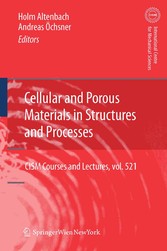Suchen und Finden
Service
Cellular and Porous Materials in Structures and Processes
Holm Altenbach, Andreas Öchsner
Verlag Springer-Verlag, 2011
ISBN 9783709102978 , 334 Seiten
Format PDF
Kopierschutz Wasserzeichen
Title Page
3
Copyright Page
4
PREFACE
5
Table of Contents
7
Fracture Mechanics of Foams
13
1 Fundamentals of Fracture Mechanics
13
1.1 Introduction
13
1.2 Linear Elastic Fracture Mechanics
15
1.3 Crack tip stress and displacement fields in anisotropic materials
24
2 Experimental Determination of Fracture Toughness of Foam Materials
28
2.1 Tear Test for Flexible Cellular Materials
28
2.2 Standard Test Methods for Plane-Strain FractureToughness and Strain Energy Release Rate of Plastic Materials
30
2.3 Fracture Toughness Experimental Results
36
2.4 Impact Fracture Toughness
41
3 Micromechanical Models for Foams Fracture
45
4 Concluding Remarks
54
Bibliography
55
Finite Element Modeling of Foams
59
1 Introduction
59
2 Homogenization and the Unit Cell Method
61
3 Micro-Mechanical Finite Element Models of Cellular Materials
69
3.1 Introduction
69
3.2 Open-Cell Foams
75
3.3 Closed-Cell Foams
79
3.4 Open-Cell Foams with Hollow Struts
84
4 Micro-Mechanical Models - Methods and Results
85
4.1 Elastic Properties
86
4.2 Yielding
87
4.3 Buckling
92
4.4 Densification
103
4.5 Fracture
105
5 Optimization of Foam Density Distribution
108
6 Summary
110
Bibliography
110
Plasticity of Three-dimensional Foams
119
1 Fundamentals of Continuum Mechanics
119
1.1 Stress Tensor and Decomposition
119
1.2 Invariants
121
1.3 Constitutive Equations
124
1.4 Linear Elastic Behaviour: Generalised Hooke'sLaw for Isotropic Materials
125
2 Constitutive Relationships for Pressure Sensitive Materials: Systematic Overview
131
3 Simple Cubic Cell Models based on Beams and Shells for Open and Closed Cell Materials
141
3.1 Relative Density
145
3.2 Geometrical Moment of Inertia
147
3.3 Young's Modulus
147
3.4 Shear Modulus and Poisson's Ratio
148
3.5 Yield Stress
152
4 Procedures to Determine the Influence of the Hydrostatic Stress on the Yield Behaviour
153
5 Implementation of New Constitutive Equations into Commercial Finite Element Codes
158
5.1 One-Dimensional Drucker-Prager Yield Condition
158
5.2 Integration of the Constitutive Equations
160
5.3 Mathematical Derivation of the Fully Implicit Backward Euler Algorithm
164
5.4 Example Problem: Return Mapping for Ideal Plasticity and Linear Hardening
170
Bibliography
176
Thin-walled Structures Made of Foams
179
1 Introduction
180
1.1 Plates as Structural Elements
180
1.2 Foams as a Material for Structural Elements
181
2 Direct Two-dimensional Plate Theory
183
2.1 Classical Approaches in the Plate Theory
183
2.2 Governing Equations
185
2.3 Material-independent Equations
186
2.4 Two-dimensional Constitutive Equations
187
2.5 Basic Equations in Cartesian Coordinates
188
3 Stiffness Identification
191
3.1 Orthotropic Material Behavior
192
3.2 Classical Stiffness Values
193
3.3 Non-classical Stiffness Values
195
3.4 Special Case - Isotropic Behavior
197
4 Examples of Effective Stiffness Properties Estimates
198
4.1 Homogeneous Plate
198
4.2 Classical Sandwich Plate in Reissner's Sense
199
4.3 Functionally Graded Materials and Foams
200
4.4 On the Plates Made of Nanofoams
205
5 Symmetric Orthotropic Plate - Static Case
208
5.1 Bending Problem - One-dimensional Case
210
5.2 Bending Problem - Two-dimensional Case
210
5.3 Bending of an Isotropic Plate
211
5.4 Bending of an Elastic Plate Made of FGM (SymmetricCase)
212
6 Dynamics of Plates Made of an Elastic Foam
213
6.1 Equations of Motion for a Symmetric Isotropic Plate
213
6.2 Free Oscillations and Dispersion curves of a Rectangular Plate
215
7 Plate Made of a Linear Viscoelastic Material
221
7.1 Constitutive Equations
221
7.2 Effective Properties
222
7.3 Bounds for the Eigen-values
226
7.4 Quasi-static Behavior of a Symmetric Orthotropic Plate
227
7.5 Examples of Effective Stiffness Relaxation Functions
229
7.6 Bending of a Viscoelastic Plate
234
8 Plate Theory Deduced from the Cosserat Continuu
238
8.1 Two-dimensional Governing Equations
238
8.2 Reduction of theThree-dimensional Micropolar Equations
240
9 Summary
244
Bibliography
246
Plasticity Theory of Porous and Powder Metals
255
1 Introduction
255
2 Fundamentals of the Theory of Plasticity
257
2.1 Rigid Perfectly/Plastic Solids
257
2.2 Rigid Plastic Hardening Solids
264
2.3 Rigid Viscoplastic Solids
265
2.4 Maximum Friction Law and Singular VelocityFields (Rigid Perfectly/Plast ic Material)
266
2.5 Maximum Friction Law and Other Models of Pressure-independent Plasticity
273
3 Plasticity Theory for Porous and Powder Metals Based on the Associated Flow Rule
274
3.1 Preliminaries
274
3.2 Yield Criteria and the Associated Flow Rule for Porous and Powder Materials
277
3.3 Additional Remarks on the Yield Criteria
282
3.4 Simple Analytic Example
283
4 Plasticity Theory for Porous and Powder Metals Based on Non-associated Flow Rules
289
4.1 Stress Equations
289
4.2 Kinematic Theories
292
4.3 The Coaxial Model
293
4.4 The Double-shearing Model
294
4.5 The Double-slip and Rotation Model
296
5 Qualitative Behavior of Plastic Solutions for Porous and Powder Metals in the Vicinity of Frictional Interfaces
297
5.1 Preliminaries
297
5.2 Statement of the Problem
297
5.3 Solution for Stresses
301
5.4 Solutions for Velocities
302
5.5 Frictional Boundary Condition
304
5.6 Solution for Pressure-independent Plasticity
311
5.7 Singularity in Velocity Fields
312
6 Applications
314
Bibliography
317
Impact of Cellular Materials
321
1 Introduction
321
2 Wave Propagation in a Cellular Rod
323
3 Rigid Object Strikes on a Cellular Rod of Fixed End
328
3.1 Basic Assumptions
328
3.2 Shock Wave Analysis
329
4 Rigid Object Strikes on a Free Cellular Rod
337
5 Concluding Remarks
345
Bibliography
345















